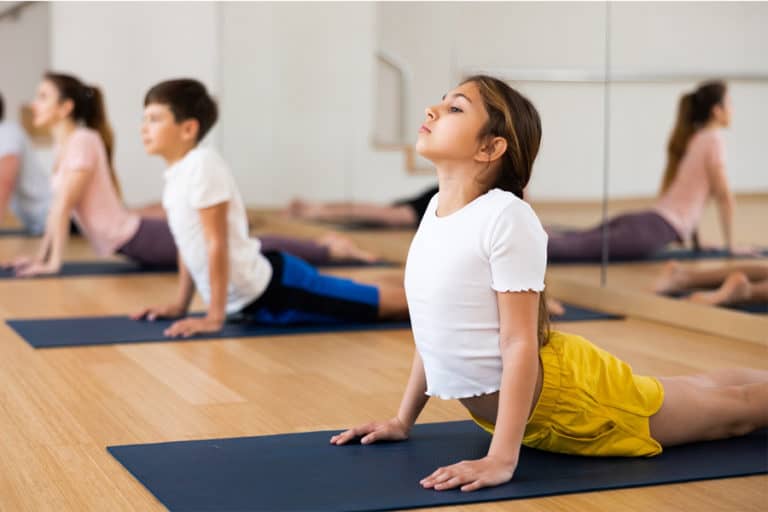15 Yoga poses For Two people – Beginners To Intermediates

Two Person yoga poses | Benefits | Safety Tips
Two person yoga, alternatively called Partner yoga or Acro Yogais a playful, therapeutic, and balance-focused branch of yoga.
While the origin of yoga goes back several centuries, 2 people yoga was developed by practitioners over time to harness the power of harmony, coordination and holistic connection.
The 2 person yoga poses listed here, provide an opportunity for playfulness, creativity, and exploration, making yoga more enjoyable and dynamic.
This practice can be deeply therapeutic. Partners can provide physical and emotional support, helping to deepen the stretches, release tension, and cultivate mindfulness and emotional well-being together.
Given below is an elaborate list and description of yoga poses for two people ranging from poses for beginners to hard yoga poses meant for seasoned yogis.
15 yoga poses for two people
Before we dive into the 15 yoga poses, let’s begin with the basics. It is best to pump up your blood as you may happen to injure yourself by stretching cold muscles. Working your muscles when they are warm gives a better result.
Warm-up!
Start by jogging, jumping, or doing high knees for 5-10 minutes to begin your warm-up. Also, ensure you have a clean, obstacle-free, and flat surface.
1. Back-to-back twist (Parivrtta sukhasana)
Back-to-back twist is a yoga pose that involves a seated spinal twist, where two individuals sit back-to-back and twist their spines in opposite directions. This two people yoga pose is also known as “seated spinal twist with partner” or “double seated twist.” This yoga pose works well to stretch out your abdominal muscles. It allows your spine to stretch out and releases the tension in your lower back.
Difficulty: Beginner
Target muscles: Core, chest, knees, lower back, arms, and shoulders

How to do
- Both partners should be sitting cross-legged with their backs against each other.
- Sit upright with an erect spine.
- Both yogis should inhale and twist from the base of their spine to their right.
- Keep your left hand on your right knee and reach your left hand to your partner’s left knee.
- Stretch your neck to your right and try to look towards your partner.
- Exhale as you release the grasp of your partner’s knee and move back to the starting position.
- Repeat the same movement on the opposite side.
2. Seated forward fold with partner (Paschimottanasana)
The seated forward fold with partner yoga pose is a variation of the classic forward fold pose, which involves two people. This yoga pose helps you release the tension in your hamstrings while giving you a stretch in your arms. Thus, it works not only your lower body but also your upper body. This pose also works well as a part of your warm-up to begin your yoga practice.
Difficulty: Beginner
Target muscles: Hamstrings, lower back, lats, forearms
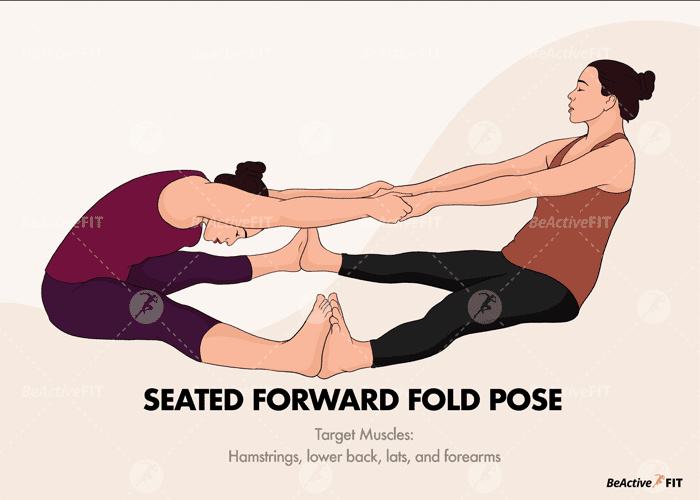
How to do
- Sit with your legs spread apart in front of each other, and ensure your legs are completely straightened.
- Your soles should be pressing against your partner’s soles.
- Hold each other’s forearms.
- Now, partner one should exhale and hinge forward. Meanwhile the other must gently pull partner one forward.
- Hold the pose for a moment.
- Inhale as you move back to the initial position.
- Then alternate the same movement with the other partner.
3. Seated cat-cow (Upavistha bitilasana marjaryasana)
Seated cat-cow pose works as a great warm-up as it helps you establish communication and synchronizes your breath work [1]National Library of Medicine: Effect of Modified Slow Breathing Exercise on Perceived Stress and Basal Cardiovascular Parameters. Moreover, it is a great way to increase the flexibility of your neck and shoulders, strengthens your spine, and activate the tailbone. A seated cat/cow is known to release tension in the upper back and stretches the abdomen. This pose also helps improve breathing, calm the mind, and relieve stress.
Difficulty: Beginner
Target muscles: Hip flexors, abdominal muscles, trapezius, spinal erectors, and lower back muscles
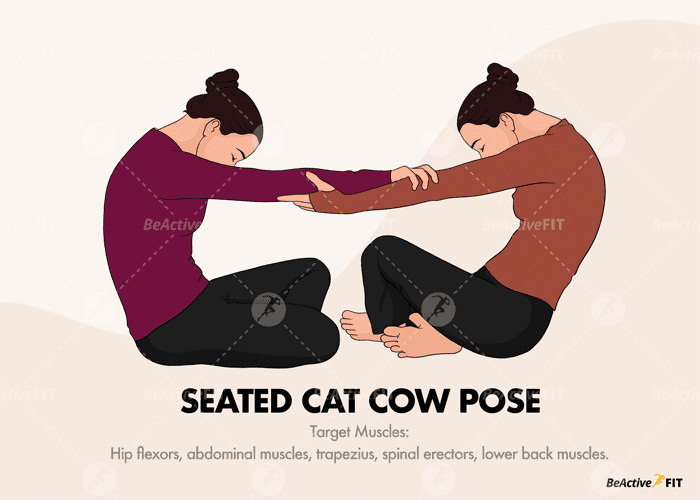
How to do
- Sit cross-legged opposite each other with knees touching.
- Hold your partner’s forearms.
- Rock back and forth for a while to build some trust.
- Inhale, and slide your shoulders down the back.
- Arch your spine, pushing your chest.
- Lean forward and lift your heads and move into the cow pose.
- Hold this stretch for 3-5 breaths.
- While exhaling, tuck in your chins.
- Round your upper backs into a C-shape/ Cat pose and suck your stomachs inwards.
- Lean your back into this C-shape till you feel a nice stretch.
- Hold the pose for a few seconds.
- Release your hold to come back to the start position.
4. Double tree pose/ Twin tree (Dvi vrksasana)
Double tree pose with a partner is a yoga pose that involves two people working together to create a symmetrical pose that requires balance, strength, and focus. It is one of the significantly easy 2 person yoga poses that help with balance and further improves posture and mental focus.
Difficulty: Beginner
Target muscles: Core, legs, inner thigh, hips, glutes, and groin muscles

How to do
- Start by standing next to each other shoulder to shoulder.
- Firmly plant your inner legs into the floor.
- Hold the weight of your body on your feet.
- Slowly raise your outer leg by bending your knees, and place your soles against the inside of your lower legs or thighs as per your balance.
- Hold each other around the waist with your arms, or you may also choose to raise your connecting arms overhead for a little challenge.
- Release your hands from around your partner’s waist and lower your legs and stand back on both feet to come back to the start position.
5. Double chair pose (Utkatasana)
Double chair pose with a partner is a yoga posture that involves two individuals standing back to back in a deep squat position, with their arms interlaced. It is a great yoga pose to strengthen your legs. The interlacing of the arms helps you give a good stretch to your shoulder and opens your chest. It is a good pose to establish stability and stamina for practicing complex yoga poses.
Difficulty: Intermediate
Target muscles: Hips, waist, abdominal area, pelvic, inner and outer thighs, and glutes
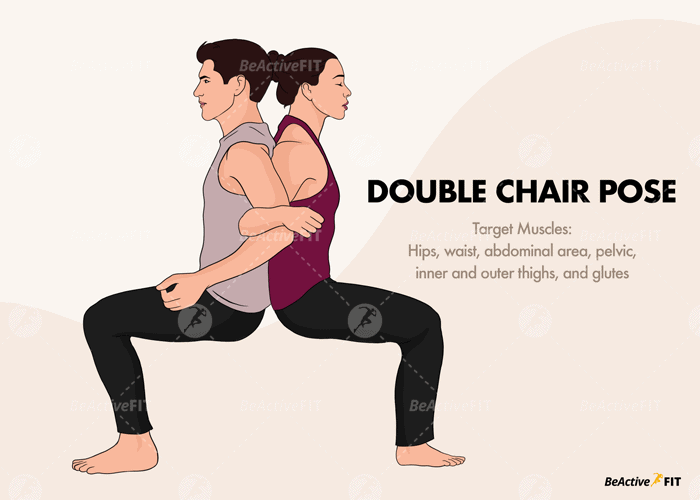
How to do
- Start by standing back to back with your partner with your feet hip-width apart.
- Entwine your arms with your partner’s hands for stability.
- Keeping your spine straight, slowly walk out a little.
- Communicate with each other and drop into a squat position gradually.
- Adjust your feet accordingly to achieve the chair pose.
- Push onto each other’s back to gain more stability.
- Hold this pose for a few seconds while focusing on your breath.
- Walk in your feet to move up and release your partner’s hands to come back to the start position.
6. Double downward dog pose (Dwi adho mukha svanasana)
Double downward dog pose with a partner involves two people performing the downward-facing dog pose together. In this pose, one person acts as the base while the other person performs the downward dog pose on top of them. This pose requires balance, strength, and trust between the partners. Moreover, it gives a good stretch to the lower back and simultaneously strengthens the upper back.
Difficulty: Intermediate
Target muscles: Shoulder, heels, calves, hamstrings, glutes, hips, wrist, and lower back

How to do
- Start the yoga pose with partner 1 by getting into the downward-facing dog.
- Facing in the same direction as partner 1, partner 2 firmly plants their palms on the floor a few steps in front of Partner 1 and gets into the same pose as partner 1.
- Partner 2 then lifts their legs and places their feet against the lower back of partner 1.
- You may consider to get your feet up partner 1’s lower back from the side to prevent any injury.
- Come back to the start pose by taking your feet off partner 1’s lower back and then standing erect.
7. Double temple pose (Utkata konasana)
Double temple pose with a partner is a dynamic yoga posture that involves two individuals working together to achieve balance, stability, and deep stretching. It is a variation of the traditional Temple Pose. This yoga pose helps you open your chest and shoulders while giving a good stretch to the spine.
Difficulty: Intermediate
Target muscles: Abdominals, hips, quads, hamstrings, and lats
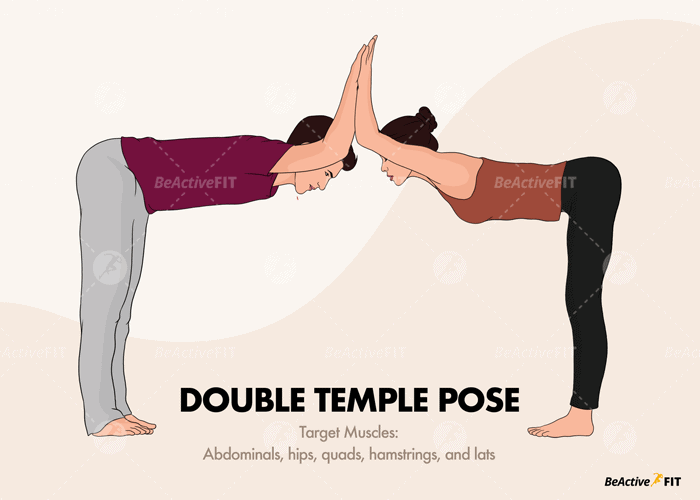
How to do
- Start by standing facing each other, keeping one hand distance.
- With your feet hip-width apart, both the partners hinge forward till their torsos are parallel to the ground.
- Inhale and bring your arms over your head and place your palms against your partner’s palms.
- Both partners must continue to hinge forward while bringing their elbows, forearms, and hands pressed against each other with equal weight.
- Exhale as you arch your back while hinging forward.
- While holding the pose, take a few breaths together.
- Walk back gently to return to the start position.
8. Double dancer (Natrajasana hasta kandra)
Double dancer yoga pose is a challenging yet rewarding yoga posture that requires coordination, communication, and trust between two individuals. This posture combines the traditional Natarajasana, or dancer pose, with the added element of another person, making it a beautiful and intimate display of trust, balance, and synchronization. It helps with improving balance and opens the heart and spine.
Difficulty: Intermediate
Target muscles: Lower back, biceps, triceps, glutes, hamstrings, chest, hips, psoas, and quadriceps
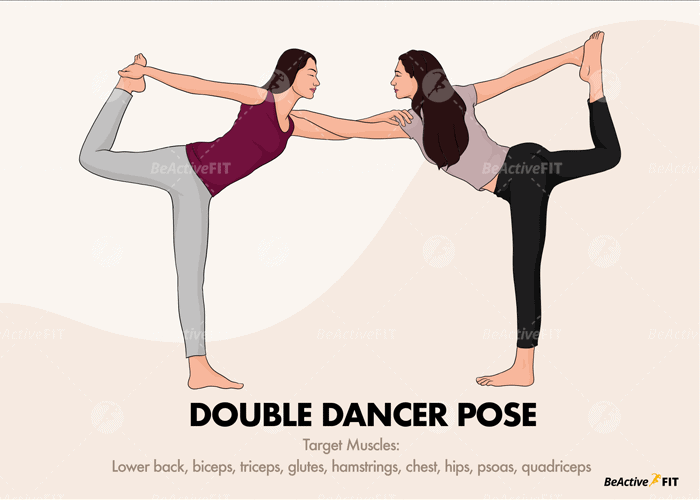
How to do
- Start by standing at the two ends of the yoga mat facing each other.
- Both partners raise their left hands to hold the other person’s left shoulder while linking their arms together.
- Firmly plant your left leg onto the ground and shift your body onto it.
- Now, both partners should bend their right knee so that they can grab their toes with their right hand.
- Slowly kick your right foot up while leaning forward towards your partner.
- Hold the dancer’s pose for a few seconds.
- Take a few breaths together as you hold the pose together.
- Gently move back into the starting position by releasing the grasp of your feet and untwining your left arm.
9. Buddy boat (Paripurna navasana)
Buddy boat yoga pose, also known as partner boat pose, is a variation of the traditional Navasana or boat pose. It involves balancing in a seated position while holding hands with your partner. This yoga pose requires coordination, balance, and trust between partners, making it a great way to build a deeper connection with your yoga partner. It stretches the hamstrings and gives relief to the lower back muscles. This pose for 2 people improves balance and stability while toning the core.
Difficulty: Intermediate
Target muscles: Hamstrings, lower back, and core muscles

How to do
- Start by sitting on the mat opposite your partner with about a half-leg distance between the two of you.
- Bend your knees and place your sole against your partner’s sole such that you form an inverse 90-degree angle.
- Grab your partner’s hand from the side.
- Move your legs together upwards slowly while keeping your core engaged to form a triangle.
- Balance your weight on your sit bones.
- Take a few breaths together as you hold the pose for a few seconds.
- Move back to the start pose by lowering your legs and releasing your hands.
10. Child’s pose assist (Balasana)
Child’s pose is a common yoga pose that is often used as a restorative posture to help calm the mind and release tension in the body. With a partner, you can receive added support and guidance, allowing you to deepen your stretch and relax more fully into the pose. The pose also helps to stretch the spine and open the hips. This posture is also beneficial for the nervous system and helps to calm the mind.
Difficulty: Intermediate
Target muscles: Lower back muscles, chest, hamstrings, and shoulders
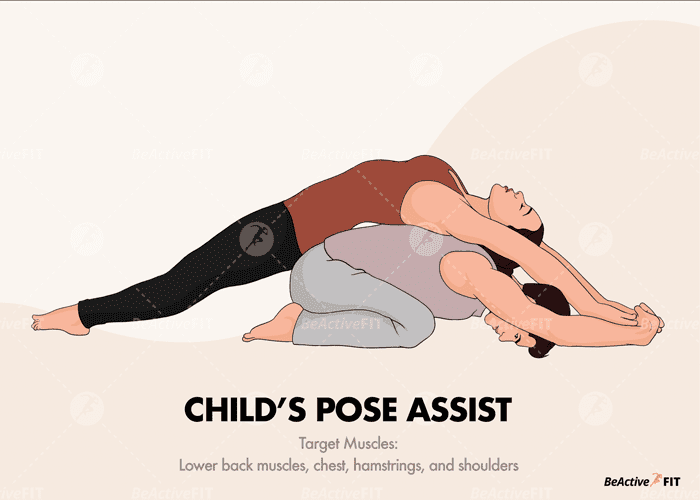
How to do
- To enter the child’s pose, partner 1 can start on all fours with knees bent and feet stretched out directly under their hips.
- Now, partner 1 bends and stretches out both arms in front of them.
- Partner 2 should face away from partner 1 and position themselves as though they are going to sit on the sacrum of partner 1.
- Now, partner 2 should slowly lower themselves down to rest their back gently on the partner1’s back.
- If partner 2 is a lot taller than partner 1, partner 2 should try moving their hips slightly lower and adjust until it’s comfortable for both partners.
- Once partner 2’s back is resting on partner 1’s, partner 2 should extend their arms over their head and try linking their fingers with partner 1 to deepen the stretch.
- Move back to the start pose by getting off partner 1’s back, and partner 1 moves back to the seated position.
11. Double plank (Phalakasana)
Double plank is a yoga pose that involves two individuals working together to achieve a deeper and more intense stretch. This yoga pose is a great way to build core strength and improve balance. This pose is not only physically beneficial but also encourages individuals to connect and work together to establish stability and trust, making it an excellent addition to any partner yoga practice.
Difficulty: Advanced
Target muscle: Arms, shoulders, biceps, triceps, core, spine, rhomboids, trapezius, and wrists
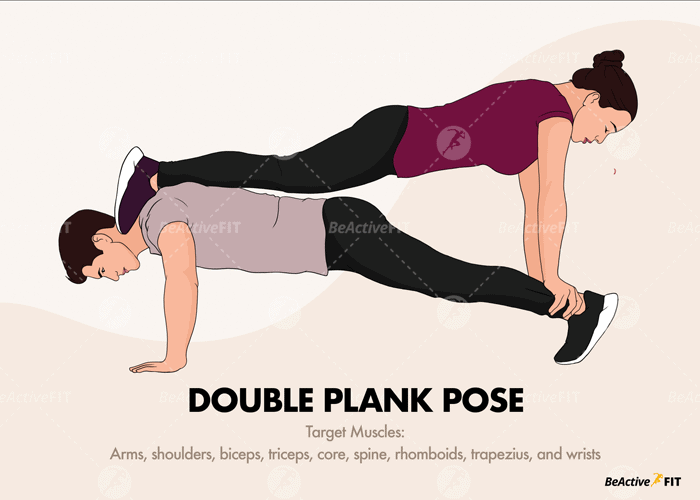
How to do
- To start, partner 1 should get into a plank position.
- Partner 2 should then grasp the ankles of partner 1 with their hands and keep their head towards the feet of partner 1.
- Partner 2 should now place their feet on the shoulders of partner 1 one after the other.
- Ensure that partner 2 has the soles of their feet facing up to the sky.
- Hold the pose for a few seconds and breathe along with your partner.
- To return to the original pose, partner 2 should slowly take their feet off the shoulders of partner 1 and stand erect.
- Partner 1 should now release the plank position and stand erect as well.
12. Extended forward leg pose (Utthita Padangusthasana)
Extended forward leg pose with a partner is a popular yoga posture that offers a range of physical and mental benefits. When performed with a partner, this pose becomes a fun and challenging variation that requires balance, strength, and flexibility. It helps to improve the strength in your hamstrings and hips but also improves your balance at the same time.
Difficulty: Advanced
Target muscles: Hamstrings, knees, and lower back

How to do
- Start by facing each other.
- Both partners should lift their right leg to their partner’s left hip.
- Balance your weight on the left leg planted on the ground.
- Now raise your respective leg onto your partner’s shoulder.
- Hold each other’s forearms for balance.
- Breathe in and out together as you hold the pose for 30 seconds to 1 minute.
- You may then switch legs and repeat on the other side.
- To go back to the standing position, release the forearms and take the legs off each other’s shoulders.
13. Wheel pose (Chakrasana)
Wheel pose is a challenging backbend that requires flexibility, strength, and proper alignment. In the partner wheel pose, two individuals work together to create a stable base and a deeper expression of the pose. Practicing wheel pose with a partner not only deepens the physical aspects of the pose, but also cultivates trust and connection between the two individuals. Just be sure to have a spotter [2]Acroyoga Austin: Teamwork and Responsibility in Acro nearby to guide you.
Difficulty: Advanced
Target muscles: Spine, arms, core, chest, hip flexors, and shoulders
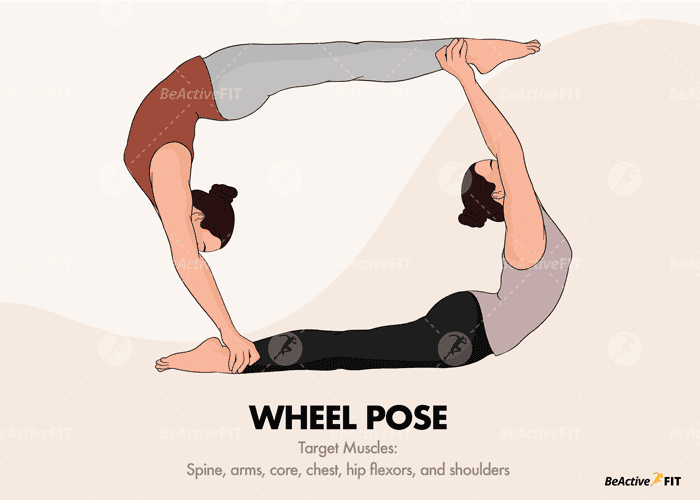
How to do
- To start the wheel yoga pose with your partner, partner 1 should get into the cobra position.
- Partner 2 then joins the pose by doing a handstand while grabbing partner 1’s ankles.
- Partner 2 then starts arching their back to form a wheel-like shape.
- Partner 1 then grabs the feet of partner 2 by extending their arms upwards.
- Hold the pose for a few seconds and take a few breaths together.
- To return to standing, partner 1 should release the grasp of partner 2’s feet and allow them to return back to their feet. Partner 1 moves off the floor and stands erect.
14. Warrior 3 (Virabhadrasana III)
Warrior 3 is a powerful yoga posture that requires strength, balance, and focus. This pose is a variation of the Warrior series and is often considered the most challenging of the three. This pose is not only physically demanding but also provides numerous benefits for the body, including strengthening the legs, core, and back muscles, improving balance, and enhancing concentration and focus.
Difficulty: Advanced
Target muscles: Shoulders, calves, ankles, back, and abdominal muscles

How to do
- Stand by facing your partner, keeping half hand distance.
- Now, bend your upper body and stretch your arms towards your partner until your fingertips touch.
- Now, stretch gently to get hold of each other’s shoulders.
- Raise your left legs parallel to the ground by keeping your right legs planted on the ground.
- Your heads should be parallel to the ground and in line with your spine.
- Hold the pose for a few seconds and breathe together.
- To return to the standing position, slowly release the grasp of your hand from your partner’s shoulder.
15. Flying Superman/Flying bird (Viparita Salabhasana)
Flying superman is an advanced yoga pose that involves one partner acting as the “Superman,” extending their arms and legs while the other partner supports them in a flying position. This pose strengthens the core, back, and leg muscles and fosters a deep sense of connection and communication between partners.
Difficulty: Advanced
Target muscles: Arms, shoulders, biceps, triceps, core, hamstrings, and quadriceps
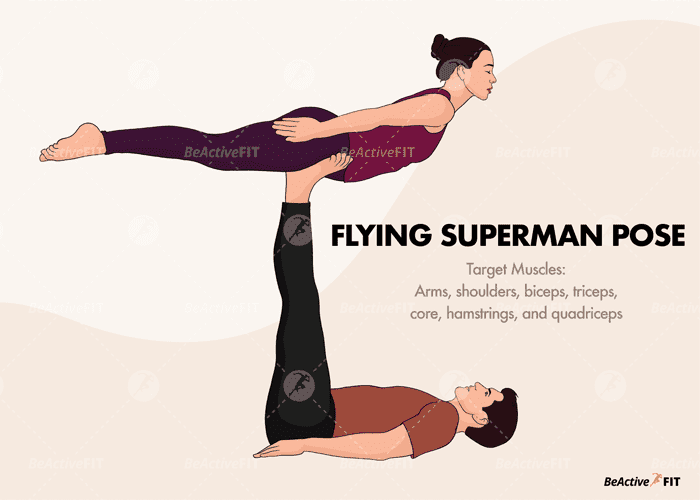
How to do
- To start the pose, partner 1 lies on their back.
- While keeping their knees bent, partner 1 places their feet on the abdomen of partner 2 .
- Both the partners now reach out and hold each other’s hand.
- Partner 1 then makes their legs perpendicular to the ground while balancing partner 2’s weight on their feet.
- Simultaneously let go of each other’s hands.
- Partner 2 may stretch their hand ahead or stretch them backward as per their preference to balance their weight.
- Hold the pose for a few seconds as you take a few breaths in and out with your partner.
- To return back to the standing position, partner 1 lowers their legs to let partner 2 down and return back to standing.
5 benefits of doing partner yoga
It is needless to say that the above-mentioned couple yoga poses have a plethora of benefits, as discussed. However, there are some unique advantages of these yoga poses for two people that have revolutionary outcomes for the mind and body. Below are some special reasons why couples yoga/partner yoga is famous.
1. Weight loss
When you are twisting and turning, working on your core strength, with the body of a partner, you may lose belly fat, tone your muscles, and increase your metabolism, all while having heaps of fun with your friend or significant other!
2. The impact of touch
Touch is an important part of partner yoga. For some, yoga poses for two people can be extremely empowering. Touch will increase your awareness of one another. Ultimately, this can have a powerful impact on your relationship – deepening the connection and understanding between you.
3. Create new experiences together
Partner yoga is an experience that you share together. These are the things that build a solid foundation for a long-lasting relationship of any kind. Couple’s yoga is a great way to learn about each other’s bodies and how to support each other in yoga practice. It is serious and playful at the same time.
4. A trust-building activity
Partner yoga requires a high level of reliance on the other person in order to complete the pose correctly. If one person falls, it is up to the other person to catch them. This builds trust through interdependency and intuition to eventually deepen the relationship.
5. Improved communication skills
In partner yoga, as each partner takes turns, it helps people to learn how to communicate more effectively and listen more carefully. It also helps them to learn how to coordinate their movements better.
Safety tips to prevent injury
Although the above-mentioned yoga poses for two people are relatively safe, there are still some safety tips that you should keep in mind to prevent injury.
- Warm up before starting the yoga poses for two people.
- Start slowly and progress gradually to the more advanced yoga poses.
- Choose yoga poses for two people that are suitable for your and your partner’s fitness level.
- Make sure that both partners are comfortable with the yoga poses before starting.
- Listen to your body and stop if either of you feel any pain.
- Yoga poses for two people should be done on a yoga mat or a firm surface.
- Wear comfortable clothes that allow you to move freely.
- Avoid yoga poses for two people if you are pregnant or have any medical conditions.
- Consult your yoga teacher or healthcare provider before starting a yoga practice.
- Practice acro yoga poses for two people under the supervision of a yoga teacher or healthcare practitioner.
Conclusion
Yoga poses for two people help you in a revolutionary way to build muscle, improve balance, flexibility, increase stamina, and overall increase the quality of life. Performing yoga with a partner helps you establish a great bond with a friend, partner, or family member while getting a workout.
Give the above-listed poses a try keeping the precautions in mind, and introduce yourself and your partner to a whole new platform to connect.
References
| ↑1 | National Library of Medicine: Effect of Modified Slow Breathing Exercise on Perceived Stress and Basal Cardiovascular Parameters |
|---|---|
| ↑2 | Acroyoga Austin: Teamwork and Responsibility in Acro |



